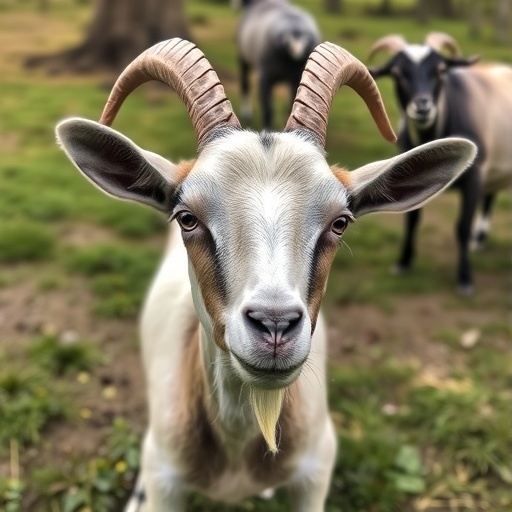In a groundbreaking development within the field of veterinary virology, researchers from Southwest Minzu University in China have identified a novel Bocaparvovirus strain present in goats, marking the first documented occurrence of this viral genus in caprine populations. Bocaparvoviruses, members of the Parvoviridae family, are small, non-enveloped, single-stranded DNA viruses that have historically posed health challenges primarily in humans and certain animal species. Until now, the existence and implications of such viruses in goats have remained elusive, with no recorded infections, thus making the discovery both pioneering and significant for animal health sciences.
The investigation originated in May 2023, when an outbreak of diarrhea afflicted a goat farm in Sichuan Province. Initial diagnostic efforts targeted common caprine enteric pathogens, including Caprine kobuvirus, Caprine enterovirus, Caprine astrovirus, and Bopivirus. Despite rigorous testing, these agents were either undetectable or only minimally present, leaving the etiology of the outbreak unexplained. This conundrum motivated researchers to employ advanced metagenomic sequencing technologies to probe the microbial composition of fecal samples more comprehensively.
Employing high-throughput sequencing, the research team isolated a robust fragment of Bocaparvovirus DNA measuring 1,832 base pairs, a critical breakthrough revealing the presence of a viral candidate potentially responsible for the diarrheal symptoms observed. Subsequent genome amplification strategies, centered on the design of six primer pairs derived from the nearly complete genome of the ECBOV-tdf70 strain—a closely related Bocaparvovirus previously identified in wild animals—enabled the researchers to assemble the complete coding sequence of the novel virus, now designated as Caprine Bocaparvovirus SWUN (CapBOV-SWUN).
The CapBOV-SWUN genome encompasses 5,351 base pairs, encoding proteins consistent with Bocaparvovirus genetic architecture, including NS1, NP1, and VP1. Comparative sequence analyses through BLASTN and BLASTX revealed remarkable nucleotide and amino acid alignments with the ECBOV-tdf70 strain, exhibiting nucleotide identities exceeding 87%, and protein coding regions sharing near or above 80% similarity. Specifically, NS1, the major nonstructural protein responsible for viral replication, showed an amino acid identity surpassing 85%, aligning well with the International Committee on Taxonomy of Viruses (ICTV) criteria for species demarcation within the genus.
The genomic homology attained compellingly suggests that CapBOV-SWUN and ECBOV-tdf70 constitute strains of the same Bocaparvovirus species. Notably, ECBOV-tdf70 was originally isolated from wildlife, indicating the potential of cross-species viral transmission events. This revelation prompts critical questions about interspecies dynamics, viral reservoirs in wild populations, and the risk posed to domestic livestock, emphasizing the necessity for vigilant surveillance across multiple animal hosts to preempt emerging infectious threats.
From a virological perspective, the detected CapBOV-SWUN strain introduces a paradigm shift in understanding Bocaparvovirus host range and pathogenic potential. The lack of prior reports of Bocaparvovirus infections in goats had previously masked the epidemiological and clinical footprint of this virus in caprine health. Given the association with a diarrheal outbreak, the virus warrants comprehensive pathogenicity studies to delineate its role in enteric disease manifestation, potential transmission mechanisms, and impacts on goat farming economics.
Metagenomic tools afforded a non-targeted, unbiased approach enabling viral discovery even when conventional pathogen screens fail, a testament to the revolution in diagnostic virology. The effort underscores the value of genomic surveillance in outbreak investigations, particularly in agricultural contexts where emergent pathogens can have profound ramifications for food security and animal welfare. Future studies integrating epidemiological modeling, in vitro infectivity assays, and longitudinal monitoring are indispensable to assess CapBOV-SWUN virulence, tropism, and potential zoonotic capabilities.
The molecular characterization of CapBOV-SWUN further advances bocaparvoviral taxonomy and enriches the phylogenetic framework of the genus. Detailed sequence analyses facilitated the mapping of conserved and variable regions within the viral genome, informing potential vaccine antigen targets and antiviral intervention strategies. The insights gleaned from CapBOV-SWUN could catalyze the development of diagnostic assays specifically tailored for Bocaparvovirus detection in goats, helping to fill a critical gap in veterinary diagnostics.
One particularly intriguing aspect is the ecological dimension inferred by the proximity of caprine Bocaparvovirus strains to those isolated from wild animals, suggesting that environmental interfaces, such as shared grazing lands or water sources, might facilitate pathogen spillover. This raises compelling considerations for integrated surveillance systems that encompass wildlife, domestic herds, and environmental samples to comprehensively map viral circulation patterns.
Given these multifaceted implications, the discovery of CapBOV-SWUN is more than a mere identification of a novel virus; it potentially signals the emergence of a new disease agent within the caprine domain. This necessitates an interdisciplinary approach combining veterinary medicine, molecular virology, ecology, and agricultural management to mitigate risks and safeguard animal populations. Additionally, this finding reminds the scientific community of the vast viral diversity yet to be characterized in livestock species and underscores the importance of proactive genomic explorations in animal health.
As the researchers emphasize, systematic epidemiological studies involving broader geographical sampling across goat-rearing regions in China and globally will be crucial to ascertain the prevalence, genetic diversity, and evolutionary trajectory of CapBOV and related bocaparvoviruses. Moreover, experimental infection studies and clinical correlation analyses will be pivotal in confirming pathogenic roles and risk assessment.
In summary, the identification of CapBOV-SWUN exemplifies the critical intersection of modern metagenomics and classical virology in unveiling hidden viral agents within important agricultural species. This discovery holds promise for improving diagnostic capabilities, informing disease control policies, and enhancing understanding of viral ecology at the human-animal interface. It also sets the stage for future scientific inquiry into viral emergence, adaptation, and interspecies transmission phenomena relevant not only to veterinary sciences but also to global health security.
Subject of Research: Not available
Article Title: A novel Bocaparvovirus in goats: Genetic features, phylogenetic analysis, and epidemiological implications.
Web References: http://dx.doi.org/10.1016/j.jia.2024.12.006
Keywords: Agriculture; Pest control; Computer science




